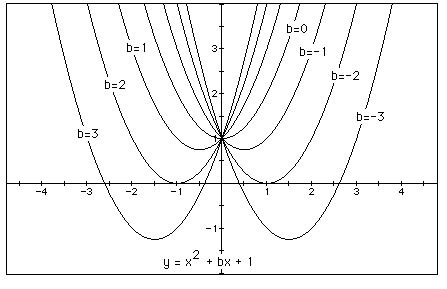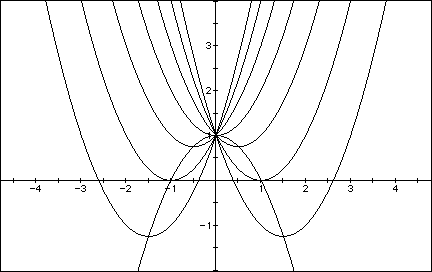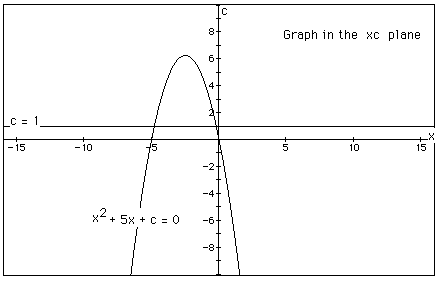

It has now become a rather
standard exercise, with availble technology, to construct graphs
to consider the equation
and to overlay several
graphs of
for different values of
a, b, or c as the other two are held constant. From these graphs
discussion of the patterns for the roots of
can be followed. For example,
if we set
for b = -3, -2, -1, 0,
1, 2, 3, and overlay the graphs, the following picture is obtained.

Let's look at the movement: Click here!

Here are some observations about the parabola:
1. We can discuss the "movement" of a parabola as b is changed.
2. The parabola always passes through the same point on the y-axis ( the point (0,1) with this equation).
3. For b < -2 the parabola will intersect the x-axis in two points with positive x values (i.e. the original equation will have two real roots, both positive).
4. For b = -2, the parabola is tangent to the x-axis and so the original equation has one real and positive root at the point of tangency.
5. For -2 < b < 2, the parabola
does not intersect the x-axis -- the original equation has no
real roots. Similarly for b = 2 the parabola is tangent to the
x-axis (one real negative root) and for b > 2, the parabola
intersects the x-axis twice to show two negative real roots for
each b.
We have already seen the graph of this parabola. The next question
is what is the locus of the vertices of the set of parabolas that
we just lookd at? Take a look at the motion of the parabola below
and follow the vertices to see what forms.
CLICK HERE to take a look.
From here we can determine that
the locus is a parabola with vertex (0,1) and x-intercepts at
1 and -1. So, the equation would be represented as y= (x - 1)(x
+ 1). This product will give us ![]() , however,
since the graph opens down we will need to change the signs to:
, however,
since the graph opens down we will need to change the signs to:
Here is a broader picture.

Consider again the equation
Now graph this relation in the xb
plane. We get the following graph.

If we take any particular value
of b, say b = 3, and overlay this equation on the graph we add
a line parallel to the x-axis. If it intersects the curve in the
xb plane the intersection points correspond to the roots of the
original equation for that value of b. We have the following graph.
So the solutions of this equation would be where the blue line
intersects the part of the graph opening upward.

Notice the following:
1. For each value of b we select, we get a horizontal line.
2. It is clear on a single graph that we get two negative real roots of the original equation when b > 2.
3. We get one negative real root when b = 2.
4. We get no real roots for -2 < b < 2 because there is not a graph in that section.
5. We get one positive real root
when b = -2, and two positive real roots when b < -2.
Consider
the case when c = - 1 rather than + 1.



In the following example the equation
is considered.
1. If the equation is graphed in the xc plane, it is easy to see that the curve will be a parabola.
2. For each value of c considered, its graph will be a line crossing the parabola in 0, 1, or 2 points -- the intersections being at the roots of the original equation at that value of c.
3. In the graph, the graph of c
= 1 is shown. The equation
will have two negative roots --
approximately -0.2 and -4.8.

Notice:
1. There is one value of c where the equation will have only 1 real root -- at c = 6.25.
2. For c > 6.25 the equation will have no real roots.
3. For c < 6.25 the equation
will have two roots, both negative for 0 < c < 6.25, one
negative and one 0 when c = 0 and one negative and one positive
when c < 0.
Return